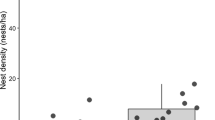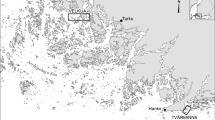Abstract
Anthropogenically introduced invasive species represent a major threat to global biodiversity by causing population declines and extinctions of native species. The negative impacts of introduced predators are well documented, yet a fundamental knowledge gap exists regarding the efficiency of potential mitigation methods to restore the ecosystem. Other understudied aspects concern prey behavioural antipredator responses and the historical context of native predator–prey interactions, which may moderate invasion impacts on native prey. Invasion impacts of American mink (Neovison vison) and raccoon dog (Nyctereutes procyonoides) into the Baltic Sea archipelago are poorly understood, and the efficiency of removal efforts as a means to alleviate depredation pressure on native prey is debated. Here, we examine the effectiveness of invasive predator removal on ground-nesting female common eider (Somateria mollissima) mortality, breeding success and breeding propensity over a 9-year period, while controlling for predation risk imposed by the main native predator, the white-tailed eagle (Haliaeetus albicilla). Our results clearly show that intensified removal of American minks and raccoon dogs decreased the number of female eiders killed during nesting, while improving both nesting success and breeding propensity. Such obvious positive effects of invasive predator removal are particularly noteworthy against the backdrop of a soaring eagle population, indicating that the impacts of invasives may become accentuated when native predators differ taxonomically and by hunting mode. This study shows that invasive alien predator removal is an effective conservation measure clearly aiding native fauna even under severe native predation pressure. Such cost-effective conservation actions call for governmental deployment across large areas.




Similar content being viewed by others
Availability of data and material
The data is available upon request from the lead author.
Code availability
Not applicable.
References
Allendorf FW, Lundquist LL (2003) Introduction: population biology, evolution, and control of invasive species. Conserv Biol 17:24–30
Beauchamp G (2004) Reduced flocking by birds on islands with relaxed predation. Proc Royal Soc B Biol Sci 271:1039–1042
BirdLife International (2015) European Red List of Birds. Office for Official Publications of the European Communities, Luxembourg
Blumstein DT, Daniel JC (2005) The loss of antipredator behaviour following isolation on islands. Proc Royal Soc B Biol Sci 272:1663–1668
Carthey AJR, Blumstein DT (2018) Predicting predator recognition in a changing world. Trends Ecol Evol 33:106–115
Christie AP, Abecasis D, Adjeroud M, Alonso JC, Amano T, Anton A, Baldigo BP, Barrientos R, Bicknell JE, Buhl DA, Cebrian J, Ceia RS, Cibils-Martina L, Clarke S, Claudet J, Craig MD, Davoult D, de Backer A, Donovan MK, Sutherland WJ (2020) Quantifying and addressing the prevalence and bias of study designs in the environmental and social sciences. Nat Commun 11:6377
Cox JG, Lima SL (2006) Naiveté and an aquatic-terrestrial dichotomy in the effects of introduced predators. Trends Ecol Evol 21:674–680
Dahl F, Åhlén PA (2019) Nest predation by raccoon dog Nyctereutes procyonoides in the archipelago of northern Sweden. Biol Invasions 21:743–755
Doherty TS, Glen AS, Nimmo DG, Ritchie EG, Dickman CR (2016) Invasive predators and global biodiversity loss. Proc Natl Acad Sci 113:11261–11265
Ehlman SM, Trimmer PC, Sih A (2019) Prey responses to exotic predators: effects of old risks and new cues. Am Nat 193:575–587
Ekroos J, Öst M, Karell P, Jaatinen K, Kilpi M (2012) Philopatric predisposition to predation-induced ecological traps: habitat-dependent mortality of breeding eiders. Oecologia 170:979–986
Ferrari MCO, Crane AL, Brown GE, Chivers DP (2015) Getting ready for invasions: can background level of risk predict the ability of naïve prey to survive novel predators? Sci Rep 5:8309
Helander B, Bignert A, Asplund L (2008) Using raptors as environmental sentinels: monitoring the White-tailed Sea Eagle Haliaeetus albicilla in Sweden. Ambio 37:425–431
Helle E, Kauhala K (1987) Supikoiran leviämishistoria ja kantojen nykytila Suomessa. (English summary: Distribution history and present status of the raccoon dog in Finland). Suomen Riista 34:7–21
Högmander J, Lokki H, Laaksonen T, Stjernberg T (2020) The Finnish White-tailed Eagle Haliaeetus albicilla population no longer endangered [in Finnish with English summary]. Linnut-Vuosikirja 2019:60–71
Holopainen S, Väänänen V-M, Fox AD (2020) Landscape and habitat affect frequency of artificial duck nest predation by native species, but not by an alien predator. Basic Appl Ecol. https://doi.org/10.1016/j.baae.2020.07.004
Hyvärinen E, Juslén A, Kemppainen E, Uddström A, Liukko U-M (2019) Suomen lajien uhanalaisuus – Punainen kirja 2019. – Ympäristöministeriö & Suomen ympäristökeskus. Helsinki 704 s
Jaatinen K, Öst M (2013) Brood size matching: a novel perspective on predator dilution. Am Nat 181:171–181
Jaatinen K, Öst M (2016) Brain size-related breeding strategies in a seabird. Oecologia 180:67–76
Jaatinen K, Öst M, Lehikoinen A (2011) Adult predation risk drives shifts in parental care strategies: a long-term study. J Anim Ecol 80:49–56
Jaatinen K, Seltmann MW, Öst M (2014) Context-dependent stress responses and their connections to fitness in a landscape of fear. J Zool 294:147–153
Jean-Gagnon F, Legagneux P, Gilchrist G, Bélanger S, Love OP, Bêty J (2018) The impact of sea ice conditions on breeding decisions is modulated by body condition in an arctic partial capital breeder. Oecologia 186:1–10
Jones HP, Tershy BR, Zavaleta ES, Croll DA, Keitt BS, Finkelstein ME (2008) Severity of the effects of invasive rats on seabirds: A global review. Conserv Biol 22:16–26
Kauhala K (1996) Introduced carnivores in Europe with special reference to central and northern Europe. Wildl Biol 2:197–204
Kauhala K (2004) Removal of medium-sized predators and the breeding success of ducks in Finland. Folia Zool 53:367–378
Lee AM, Reid JM, Beissinger SR (2017) Modelling effects of nonbreeders on population growth estimates. J Anim Ecol 86:75–87
McGeoch MA, Jetz W (2019) Measure and reduce the harm caused by biological invasions. One Earth 1:171–174
Melero Y, Robinson E, Lambin X (2015) Density-and age-dependent reproduction partially compensates culling efforts of invasive non-native American mink. Biol Invasions 17:2645–2657
Nordström M, Högmander J, Laine J, Nummelin J, Laanetu N, Korpimäki E (2003) Effects of feral mink removal on seabirds, waders and passerines on small islands in the Baltic Sea. Biol Cons 109:359–368
Öst M, Jaatinen K (2015) Smart and safe? Antipredator behavior and breeding success are related to head size in a wild bird. Behavioural Ecology 26:1371–1378
Öst M, Steele BB (2010) Age-specific nest-site preference and success in eiders. Oecologia 162:59–69
Öst M, Ydenberg R, Kilpi M, Lindström K (2003) Condition and coalition formation by brood-rearing common eider females. Behav Ecol 14:311–317
Öst M, Lehikoinen A, Jaatinen K, Kilpi M (2011) Causes and consequences of fine-scale breeding dispersal in a female-philopatric species. Oecologia 166:327–336
Öst M, Ramula S, Lindén A, Karell P, Kilpi M (2016) Small-scale spatial and temporal variation in the demographic processes underlying the large-scale decline of eiders in the Baltic Sea. Popul Ecol 58:121–133
Öst M, Lindén A, Karell P, Ramula S, Kilpi M (2018) To breed or not to breed: drivers of intermittent breeding in a seabird under increasing predation risk and male bias. Oecologia 188:129–138
Preisser EL, Bolnick DI, Benard MF (2005) Scared to death? The effects of intimidation and consumption in predator-prey interactions. Ecology 86:501–509
R Core Team (2019) R: A language and environment for statistical computing. R Foundation for Statistical Computing, Vienna, Austria
Rayner MJ, Hauber ME, Imber MJ, Stamp RK, Clout MN (2007) Spatial heterogeneity of mesopredator release within an oceanic island system. Proc Natl Acad Sci 104:20862–20865
Ritchie EG, Johnson CN (2009) Predator interactions, mesopredator release and biodiversity conservation. Ecol Lett 12:982–998
Rogers HS, Buhle ER, Hille Ris Lambers J, Fricke EC, Miller RH, Tewksbury JJ (2017) Effects of an invasive predator cascade to plants via mutualism disruption. Nat Commun 8:1–8
Salo P, Korpimäki E, Banks PB, Nordström M, Dickman CR (2007) Alien predators are more dangerous than native predators to prey populations. Proc Royal Soc B Biol Sci 274:1237–1243
Salo P, Nordström M, Thomson RL, Korpimäki E (2008) Risk induced by a native top predator reduces alien mink movements. J Anim Ecol 77:1092–1098
Shaw AK, Levin SA (2013) The evolution of intermittent breeding. J Math Biol 66:685–703
Sih A, Englund G, Wooster D (1998) Emergent impacts of multiple predators on prey. Trends Ecol Evol 13:350–355
Sih A, Bolnick DI, Luttbeg B, Orrock JL, Peacor SD, Pintor LM, Preisser E, Rehage JS, Vonesh JR (2010) Predator-prey naivete, antipredator behavior, and the ecology of predator invasions. Oikos 119:610–621
Tilman D, Clark M, Williams DR, Kimmel K, Polasky S, Packer C (2017) Future threats to biodiversity and pathways to their prevention. Nature 546:73–81
Tjørnløv RS, Ens BJ, Öst M, Jaatinen K, Karell P, Larsson R, Christensen TK, Frederiksen M (2020) Drivers of spatiotemporal variation in survival in a flyway population: A multi-colony study. Front Ecol Evol 8:566154
Treinys R, Dementavičius D, Rumbutis S, Švažas S, Butkauskas D, Sruoga A, Dagys M (2016) Settlement, habitat preference, reproduction, and genetic diversity in recovering the white-tailed eagle Haliaeetus albicilla population. J Ornithol 157:311–323
Zalewski A, Piertney SB, Zalewska H, Lambin X (2009) Landscape barriers reduce gene flow in an invasive carnivore: geographical and local genetic structure of American mink in Scotland. Mol Ecol 18:1601–1615
Zanette LY, White AF, Allen MC, Clinchy M (2011) Perceived predation risk reduces the number of offspring songbirds produce per year. Science 334:1398–1401
Acknowledgements
We thank H. Koskivirta (aided by Gunnar and Rudolf) and R. Remes for teaching KJ the intricacies of invasive predator removal and for implementing the invasive predator removal scheme from its start in 2011. We thank I. Herlin (aided by Kapu) for frequent and valuable help on invasive predator removal. We thank H. Eriksson and S. Neggazi as well as several field assistants over the years for assistance in the field as well as the reviewers of this paper for many improvements. We thank Tvärminne Zoological Station for facilities and for supporting the predator removal scheme over the years and the Finnish Ministry of Agriculture and Forestry for recent support.
Funding
KJ was funded by a grant from Sophie von Julins Stiftelse (to the Nature and Game Management Trust Finland), IH by The Finnish Foundation for Nature Conservation, Waldemar von Frenckells stiftelse and Nordenskiöld-samfundet, BM by the Åbo Akademi University doctoral network and MÖ by the Swedish Cultural Foundation in Finland (grants no. 158026, 149014, 138139, 17/3317, 16/1476, 15/3296, 14/2657, 13/2654).
Author information
Authors and Affiliations
Contributions
KJ and MÖ conceived the idea for this study; KJ conducted and coordinated the IAP removal scheme; KJ, IH, BM, MÖ and BS conducted field work regarding eider breeding; KJ conducted the statistical analyses; KJ, IH, BM, MÖ and BS wrote and commented upon previous versions of the paper.
Corresponding author
Ethics declarations
Conflict of interest
The authors declare that there is no conflict of interest or competing interests regarding this paper.
Ethics approval
All procedures performed in studies involving human participants were in accordance with the ethical standards of the institutional and/or national research committee and with the 1964 Helsinki Declaration and its later amendments or comparable ethical standards. Eider female handling procedures were approved by the Animal Experiment Board at the State Provincial Office of Southern Finland (permit number ESAVI/4053/2018). Female trapping procedures and IAP removal also complied with the specific regulations of the Tvärminne Zoological Station.
Consent to participate
Not applicable.
Consent for publication
All authors have given their consent to publishing the final version of this paper.
Additional information
Communicated by Michael Sheriff.
Rights and permissions
About this article
Cite this article
Jaatinen, K., Hermansson, I., Mohring, B. et al. Mitigating impacts of invasive alien predators on an endangered sea duck amidst high native predation pressure. Oecologia 198, 543–552 (2022). https://doi.org/10.1007/s00442-021-05101-8
Received:
Accepted:
Published:
Issue Date:
DOI: https://doi.org/10.1007/s00442-021-05101-8




